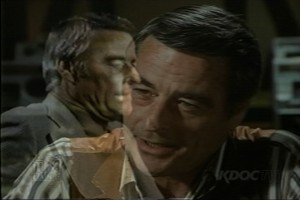Single-screen video, 2009, 57 minutes
Structured as a standard 1970s prime-time TV drama, The Following is constructed through a superimposition of 18 episodes from a variety of series all featuring guest appearances from noted character actor Robert Webber. All visual and sound material not featuring the actor was excised, projecting his persona to the forefront, traveling at once through a linear narrative arc as well as in “temporal depth” through a decade of material. The video is structured in four acts (like the standard Quinn-Martin approach) separated by period commercials (with sound alteration). No attempt was made to line up various occurrences between episodes, after all sound and image materials not involving Webber were removed. All resultant relationships (Webber “talking to himself” across episodes, enacting simultaneous multiples of conventional filmic tropes) are purely fortuitous, and only serve to reinforce the omnipresence of TV drama form.
The Following meditates on the discrepancies between visual and acoustic spaces: multiple narrative strands, taking place simultaneously in both image and sound, lead the viewer to process seemingly incompatible yet plausible occult relationships, all the while “following” 18 overlapping and crisscrossing storylines. An individual will be watching one piece and listening to another, even though they both happen at the same time. Two radically different activities, decoupled from each other, masquerading as one single activity. One could think of The Following as a “sound work with image”, the “supplemental” image being overlaid on top of the sound. The visual lends to the sound a localizable specificity, which the sound on its own resolutely refuses to inhabit. In the acoustic space of the work, simultaneities are the rule. Multiple sound overlays are easily accepted as collapsed into /coexisting in one unified space. It is possible to alternate between visual and acoustic spaces by periodically closing your eyes and listening to the sound alone. An internal coherence begins to form itself, relationships are mobilized, merged together. When you open your eyes, you hit the ground running.
The Following also addresses the “legislative” aspects of formulaic structures (such as the standard one-hour drama). Though the narrative surface is comprised of a set of non-sequiturs arising from storylines collapsed into one another, the stability of the form in question makes it possible to nevertheless make sense of nonsensical content, which has provided insight into the deus ex machina capacities of form to override conventional semantics under the umbrella of a standardized, internalized narrative arc. Form persists, ventriloquizing content. (You know you’re listening to nonsense, but this fact does not impede your ability to continue entertaining a linear narrative). When forms have become legislating bodies, does it matter what one says within them?
Conceptual artist Douglas Huebler said in 1969: “The world is full of objects, more or less interesting; I do not wish to add any more.” In that spirit, the work I have made over the past few years has begun a period of reclamation, by which I mean the resituating of familiar images and sounds. Or the imposition of a set of filters over material which one might think has been fully grasped long ago. A way of looking at things from an oblique angle. Several sections of 68/70 (including The Following) were screened in October 2009, as part of the interdisciplinary San Francisco organization NexMap’s regular season.
Series used in The Following: Barnaby Jones, Cannon (x4), Ironside, Kojak, The Magician, Mannix, Police Woman, Quincy (x2), The Rockford Files (x3), Search, S.W.A.T., Switch.
____________________________________________
Paradox coalesces or telescopes various facets of a complex process in a single instant. (Marshall McLuhan)
A misunderstanding of another work, heard about, not seen.
A TV situation – well, 18 TV situations really – meant to be viewed in the same way as an episode of Kojak. Except that you’re watching an episode of Kojak, Barnaby Jones, Ironside, The Magician, Mannix, Police Woman, Search, S.W.A.T. and Switch (three siblings?), 2 Quincys, 3 Rockford Files and 4 Cannons. This work being the 19th situation.
Watching one work and listening to another. At the same time.
Self-sufficient sound with image as supplement.
(Close your eyes to periodically verify).
Form ventriloquizing content.
Omniscient narration tilting into internal monologue flipping into sync sound in the recursive rhythms of the möbius strip (thanks to Morgan Fisher and Edgar G. Ulmer).
Advisory: the location of each fragment is exactly where it occurred in the time structure of the original TV drama. No tracks were shifted, exchanged or otherwise harmed. All coincidences are therefore resemblant.
This piece was constructed subtractively in accordance with certain principles of anarchitecture.

